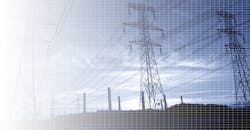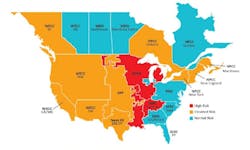The Electric Grid’s ‘Hyper-Complex’ Risk Environment
As a consumer or as a manufacturer, you may sense that electric power is becoming more expensive, or more restricted, or more erratic. And you’d be right. But do you know why? Insiders know of the decreasing reliability of our electric grid. But you should learn why “grid down” events are becoming more likely, and how to avoid – or even benefit from them.
For background, understand that the “grid” is probably one of the largest machines ever built by man. Its purpose is electricity collection and distribution, and it’s all interconnected, all instantaneous, but it is built from many different operating parts. It began to form about 100 years ago, when electricity suppliers figured out that AC power could be transmitted at long distances and distributed. From that, the electricity-generating industry grew at a phenomenal rate.
The industry’s initial years saw confusion because the industry was totally unregulated. There were competing utility companies trying to provide power, and eventually the government stepped in to organize the industry. Congress basically told the states they needed to provide the legislative framework and enforcement of the electricity network – basically to manage the emerging industry.
And that helped for quite a while. In fact, up until probably about 20 years ago all the states managed their own electrical infrastructures. They set up local utilities with monopolistic coverage, so that energy companies had no competition. Basically, electric power generation grew into a vertical industry: they produced electricity, they delivered it, they did customer maintenance and all of that. As the industry continued to grow, some of the larger electric utilities wanted to expand to work with electric utilities in other states. And so they started to put together interconnections, but that structure needed organization and control too.
And so these utilities established independent system operators – or regional grid operators. The ISOs’ role is to manage the overall grid by performing a balancing function, managing electricity supply and demand. With that in place they established grid interconnections, large networks like the Midcontinent Independent System Operator (MISO) operating in the upper Midwest and Mississippi Valley, that manage electricity supply and distribution across the U.S. and Canada.
Governing the grid
Different grid operators may develop some conflicts at times, and so these different business entities formed the North American Electric Reliability Corporation (NERC), the mission of which is to ensure the effective and efficient reduction of risks to the reliability and security of the electrical grid.
So, NERC really is the controlling arm for the operation of the grid that delivers electricity to businesses and consumers. But, meanwhile, a great deal of the planning and the pricing models for power generation and delivery are still done at the state level. And that now means a real mixed bag of priorities and objectives for power supplies. In Illinois, for instance, lawmakers have now established that the supply of electricity in their state must be 100% carbon-free by 2050. It’s just one of many examples of different objectives or agendas entering into the business of generating and delivering electricity.
“The electric sector risk environment has rapidly evolved and is hyper-complex, stemming from grid transformation, increasingly frequent extreme weather systems, escalating physical and cyber security threats,” explained NERC president and CEO Jim Robb, in a presentation last year.
1. According to NERC, the complex of risks include:
- A rapidly changing mixture of energy resources due to
- Retirements of traditional generating sources
- Natural gas interdependencies
- Inverter-based resource (IBR) integration
- Distributed energy resources (DER) performance and visibility
2. Extreme weather complexities
- Extreme, not infrequent
- Broader, deeper, longer
3. Energy and Environmental policies
- Electrification
- Emissions
4. Rapidly evolving threat landscape
- Software vulnerabilities
- Supply chain
- Ransomware
- Physical attacks
Overseeing the electrical supplies at the federal level is Federal Energy Regulatory Commission (FERC), and its top official has confirmed the risk environment. Last June, FERC commissioner Mark C. Christie testified to the House Subcommittee on Energy, Climate and Grid Security that the U.S. electric power system is headed for “potentially catastrophic consequences” as dispatchable generating resources are retiring “far too quickly” and in quantities that “threaten our ability to keep the lights on.”
The problem, Christie testified, is “not the addition of intermittent resources such as wind and solar, but the far too rapid subtraction of dispatchable resources, especially coal and gas.”
NERC and FERC are not alone. According to the Midcontinent Independent System Operator (MISO) 2024 Reliability Imperative report, "There are urgent and complex challenges to electric system reliability in the MISO region and elsewhere. This is not just MISO’s view; it is a well-documented conclusion throughout the electric industry."
Their warnings are based on evidence. In December 2022, a record-setting 90.5 GW, or 13% of the generating capacity in the Eastern Interconnection (the grid covering two-thirds of the U.S.) failed to run or operated at reduced capacity during Winter Storm Elliott.
Earlier, in February 2021, a severe cold weather event (Winter Storm Uri) caused numerous outages, derates, or failures to start at electric generating plants across Texas and South Central states. About 4.5 million people lost power (some for as long as four days) during the freezing conditions.
"From February 8 through 20, in the Event Area, a total of 1,045 individual generating units—58 percent natural gas-fired, 27 percent wind, six percent coal, two percent solar, seven percent other fuels, and less than one percent nuclear—experienced 4,124 outages, derates or failures to start," FERC reported.
The risk environment
With all this uncertainty and near-miss catastrophe – what can manufacturers do to avoid the "hyper-complex risk" of the electric grid?
Install on-site, independent power-generation capability to support your manufacturing operation, to protect your assets, profits and business. Choose generating functionality that will work with or without grid power. Use that capability as your emergency backup power source, or as a peak-cost shaving tool. Or use on a continuous basis… Your choice.
Consider the benefits and advantages for on-site power generation. Have you calculated the lost-production cost for every hour you have no electricity and your operation may be down?
Also, electric utility costs continue to rise, and about half of your electric utility bill is for delivery of grid power. The delivery infrastructure needs massive upgrades and the utility customers will be paying for it.
Running your generator(s) will directly reduce your utility electric bill. And, when the power is out, on-site power generation will mean you continue to operate when your competitors may not.
Many factors must be considered to provide an estimate of the financial implications for your company. We provide a no-obligation analysis of those factors for your consideration, including estimated ROI, NPV, IRR, and more. Our analysis will be tailored to your local electric utility costs, as well as your preferred generation solutions.
Brian Reinke, president of TDI Consulting, is an energy-cost saving consultant.
About the Author
Brian Reinke
President
Brian Reinke, president of TDI Energy Solutions, is an energy-cost saving consultant. Contact him at 630-343-0971.

